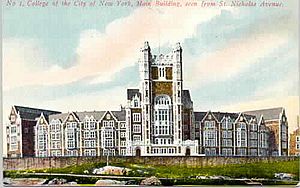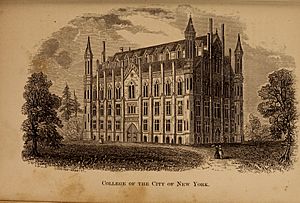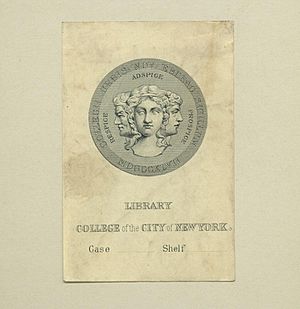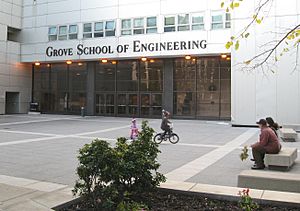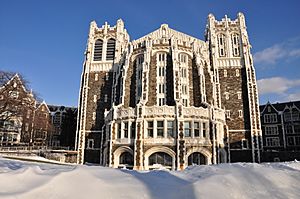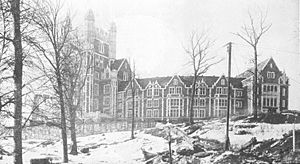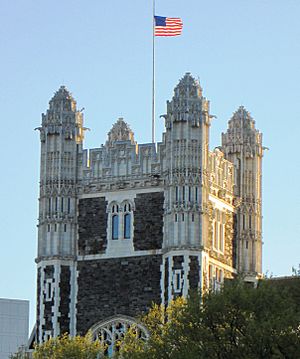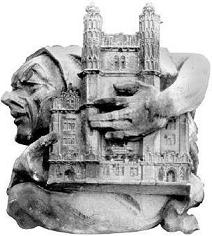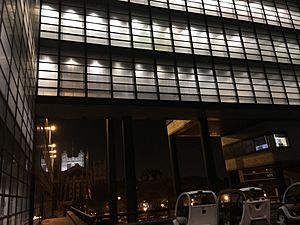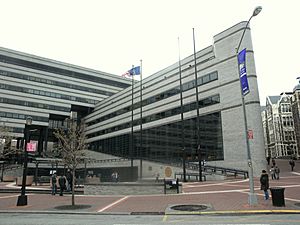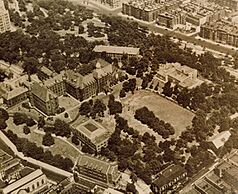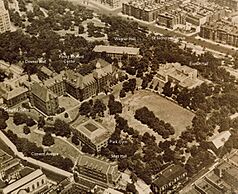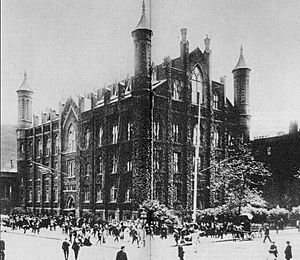City College of New York facts for kids
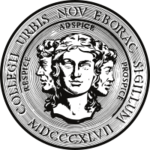 |
|
|
Other names
|
City College of New York City College |
|---|---|
|
Former names
|
Free Academy of the City of New York (1847–1866) College of the City of New York (1866–1929) City College of New York (1929–1961) |
| Motto |
Respice, Adspice, Prospice (Latin)
|
|
Motto in English
|
"Look behind, look here, look ahead" |
| Type | Public research university |
| Established | 1847 |
| Founder | Townsend Harris |
|
Parent institution
|
City University of New York |
| Accreditation | MSCHE |
|
Academic affiliations
|
|
| Endowment | $290 million (2019) |
| President | Vincent G. Boudreau |
| Provost | Tony Liss |
|
Academic staff
|
581 (full-time) 914 (part-time) |
|
Administrative staff
|
401 |
| Students | 14,489 (Fall 2022) |
| Undergraduates | 13,113 |
| Postgraduates | 3,048 |
| Location |
,
,
United States
40°49′10″N 73°57′00″W / 40.8194°N 73.9500°W |
| Campus | Large City, 35 acres (0.14 km2) |
| Newspaper |
|
| Colors | Lavender/purple, gray, and white |
| Nickname | Beavers |
|
Sporting affiliations
|
NCAA Division III – CUNYAC |
| Mascot | Benny the Beaver |
 |
|
The City College of the City University of New York (also known as City College of New York or City College or CCNY) is a public university in New York City. It is part of the City University of New York (CUNY) system. Founded in 1847, City College was the first free public college in the United States. It is the oldest of CUNY's 25 schools. Many people consider it the most important school in the CUNY system.
The main campus is in the Hamilton Heights neighborhood. City College's campus is 35 acres (14 hectares) big. It stretches along Convent Avenue from 130th to 141st Streets. An architect named George B. Post first designed it. City College also has a smaller campus downtown. It has been open since 1981 and offers programs for adults who work.
City College was also the first in the nation to have a student government (in 1867). It also had the first national club to accept members no matter their religion or race (Delta Sigma Phi, 1899). It was also the first to offer college degrees for evening classes (School of Education, 1907). In 1949, students led a large protest to make dorms fair for all races. The college is known for its research activities.
Contents
History of City College
How City College Started
The City College of New York began as the Free Academy of the City of New York in 1847. It was started by a rich businessman named Townsend Harris. He was also the president of the Board of Education. This school was like a mix of a high school and a college. It gave children of immigrants and poor families a chance to get a free college education. Students were accepted based only on how well they did in school.
The Free Academy was the first of many colleges supported by the city. Hunter College was founded for women in 1870. Brooklyn College was started for both men and women in 1930.
In 1847, New York State Governor John Young allowed the Free Academy to be founded. People across the state voted to approve it. Townsend Harris said, "Open the doors to all... Let the children of the rich and the poor take their seats together." He wanted everyone to be treated equally based on their hard work and intelligence.
Horace Webster (1794–1871) was the first president of the Free Academy. He was a graduate of the United States Military Academy at West Point. When the Free Academy officially opened on January 21, 1849, Webster said: "The experiment is to be tried, whether the children of the people... can be educated." He meant that they would see if everyone, not just a few rich people, could get a good education.
In 1847, the school decided on nine main subjects to teach. These included math, history, languages, and science. The first students graduated in 1853.
The Free Academy was open to everyone from the start. In 1854, a famous scientist named Oliver Wolcott Gibbs was not hired by Columbia University. This was because of his religious beliefs. But Gibbs had been a professor at the Free Academy since 1848. He later taught at Harvard College.
The Townsend Harris Hall Prep School opened on campus in 1849. It was a one-year school to prepare students for City College. Later, in the early 1900s, President John H. Finley made changes. He stopped making students attend religious services. This was important as more Jewish students joined the college.
Changes in the Late 1800s
In 1866, the Free Academy changed its name to the College of the City of New York. It was only for men at that time. In 1929, it became the City College of New York. Finally, in 1961, it became part of the larger City University of New York (CUNY) system. But many people still call it City College of New York or just City College.
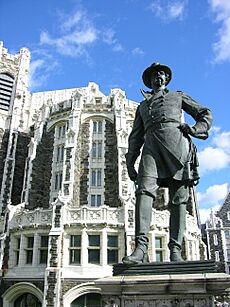
When the name changed in 1866, lavender was chosen as the college's color. In 1867, the academic senate was formed. This was the first student government in the country. In 1895, the state government allowed City College to build a new campus. A four-block area in Harlem was chosen. The college quickly grew even bigger than this area.
The second president of City College was General Alexander S. Webb (1835–1911). He was also a graduate of West Point. He became president in 1869 and served for almost 30 years. General Webb was a hero in the Battle of Gettysburg. In 1891, he received the Medal of Honor for his bravery. A statue of General Webb stands on the campus today.
Under Presidents Webster and Webb, the college taught both classic subjects like Latin and Greek. It also taught practical subjects like chemistry, physics, and engineering. General Webb was followed by John Huston Finley in 1903. Finley made the college less strict. He ended the rule that students had to attend religious services.
In 1899, a club called Delta Sigma Phi was started at City College. It was the first national club of its kind to accept members no matter their religion or race. Before this, other clubs at City College had not accepted Jewish students.
Early 1900s at City College
In 1897, the college started offering classes for teachers. This was because a city law said teachers needed proper schooling. The School of Education was officially started in 1921. The college newspaper, The Campus, printed its first issue in 1907. Also, the first college evening classes that gave degrees in the United States began here.
In the early 1900s, many private colleges were only for certain groups of people. So, thousands of very smart students, including many Jewish students, came to City College. They had no other choice. City College was known for its excellent academics and for being a school for working-class students. People called it the "Harvard of the Proletariat" or the "poor man's Harvard."
Separate schools for Business and Engineering were started in 1919. In 1947, the college celebrated its 100th birthday. They gave special degrees to famous alumni like Bernard Baruch and Robert F. Wagner. A time capsule was buried on campus.
Until 1929, City College was only for male students. In 1930, women were allowed to join for the first time, but only for advanced degrees. In 1951, the whole college became open to both men and women.
Ten City College graduates from the mid-1900s later won Nobel Prizes. Many City College alumni also served in the U.S. Armed Forces during World War II. A total of 310 alumni died in the war. Before World War II, many City College alumni volunteered to fight in the Spanish Civil War. Thirteen alumni died in Spain.
In the 1930s to 1950s, City College was known for its strong political discussions. People said that the old cafeteria in Shepard Hall was the only place where different political groups could have a fair debate.
In 1939, the Philosophy Department invited a famous British mathematician and philosopher, Bertrand Russell, to teach. Some people protested his appointment. A woman filed a lawsuit to stop him from teaching. She said his ideas on marriage would harm her daughter, even though her daughter was not a student there. Russell lost the lawsuit. He later wrote in a book that he was "Judicially pronounced unworthy to be Professor of Philosophy at the College of the City of New York."
City College in the Late 1900s
In 1945, a case called the Knickerbocker Case started. William E. Knickerbocker, who led the romance languages department, was accused of treating some faculty members unfairly. In 1949, he was accused again, this time for not giving honors to high-achieving Jewish students. Around the same time, a professor named William C. Davis was accused of having a dorm that separated students by race.
City College students, many of whom were World War II veterans, held a huge protest in 1949. They were protesting against Knickerbocker and Davis. The New York Times called it "the first general strike at a municipal institution of higher learning."
In the late 1960s, students became more active in protests. This was during the Civil Rights Movement and protests against the Vietnam War. In 1969, students at City College protested and took over part of the campus. African American and Puerto Rican students and their friends demanded changes. They wanted the college to accept more minority students and give them academic help. Some protesters even called City College "Harlem University."
At first, the CUNY administration did not agree to all demands. Instead, they started an "open admissions" program. This meant any high school graduate from New York City could go to City College or another CUNY school. This program started in 1970. It allowed many more people to go to college who might not have been able to before. However, this also made it harder for the college to keep its high academic reputation. It also put a strain on New York City's money. A movie called The Five Demands (2023) tells the story of these protests.
City College started charging tuition in 1976. By 1999, CUNY decided to stop offering basic review classes at its main colleges. This ended the "open admissions" policy. Students who needed more help had to go to community colleges first. Since this change, CUNY colleges, especially City College, have become more respected nationally. This is shown by their rankings and the good grades of new students.
In 1989, students protested tuition increases. As a result, a community center was opened on campus. It was named the Guillermo Morales/Assata Shakur Community and Student Center. Students and local people used the center to organize against racism and other issues. In October 2013, City College closed the center. They said they needed the space for a career center. This closure led to more student protests.
City College's new Frederick Douglass Debate Society won against Harvard and Yale in a big debate competition in 1996. In 2003, the college's Model UN Team won an award at a national conference. They won this award four years in a row.
The U.S. Postal Service made a postcard to celebrate City College's 150th birthday in 1997. It showed Shepard Hall.
City College in the 2000s
In 2000, the City University of New York started a program for top students called University Scholars. City College was one of the first schools to have this program. Students in the CCNY Honors College get free tuition. They also get a "cultural passport" for free or cheap entry to New York City cultural places. They receive a laptop and money for school activities like studying abroad. These students take special honors classes. In 2007, the CUNY Honors College was renamed Macaulay Honors College.
In October 2005, Andrew Grove, who graduated from the Engineering School in 1960, gave $26 million to the Engineering School. He was a co-founder of Intel Corporation. The school was then renamed the Grove School of Engineering. This was the largest gift ever given to City College.
In August 2008, City College's Grove School of Engineering was given the power to grant advanced engineering degrees.
In 2009, the School of Architecture moved into a newly renovated building. It was designed by architect Rafael Viñoly. Also in 2009, the school was renamed the Bernard and Anne Spitzer School of Architecture. This was to honor a $25 million gift from the Spitzers.
In May 2023, City College announced it would open a center to help students who are immigrants.
In April 2024, students and faculty set up a protest camp on the City College campus. Less than a week later, on April 30, 2024, the New York City Police Department came to the campus. They removed the camp and arrested 173 people.
Presidents of City College
Here are the people who have led City College over the years:
- Horace Webster, 1847–1869
- Alexander S. Webb, 1869–1902
- John Huston Finley, 1903–1913
- Sidney Edward Mezes, 1914–1927
- Frederick B. Robinson, 1927–1938
- Nelson P. Mead (acting), 1938–1941
- Harry N. Wright, 1941–1952
- Buell G. Gallagher, 1953–1961, 1962–1969
- Harry N. Rivlin (acting), 1961–1962
- Joseph J. Copeland (interim), 1969–1970
- Robert Marshak, 1970–1979
- Alice Chandler (interim), 1979–1980
- Arthur Tiedemann (interim), 1980–1981
- Bernard W. Harleston, 1981–1992
- Augusta Souza Kappner (interim), 1992–1993
- Yolanda T. Moses, 1993–1999
- Stanford A. Roman Jr. (interim), 1999–2000
- Gregory H. Williams, 2001–2009
- Robert "Buzz" Paaswell (interim), 2009–2010
- Lisa S. Coico, 2010–2016
- Vincent G. Boudreau (interim), 2016–2017
- Vincent G. Boudreau, 2017–Present
City College Campuses
North Campus Buildings
City College's North Campus was built in 1906. It replaced an older campus downtown. This new campus was designed by George Browne Post. The buildings look like old English castles. They were some of the first buildings in the U.S. to be built in this style. Construction for these buildings started in 1903. There were five main buildings built between 1906 and 1908: Shepard Hall, Baskerville Hall, Compton Hall, Harris Hall, and Wingate Hall.
Shepard Hall is the biggest building and the center of the campus. It looks like a Gothic cathedral. It has a large assembly hall called the Great Hall. This hall has a mural called "The Graduate" by Edwin Blashfield. Another mural, "The Great Teachers," was painted by Abraham Bogdanove in 1930. The building is named after Edward M. Shepard.
Baskerville Hall used to hold the Chemistry Department. It is now home to HSMSE, a high school for math, science, and engineering.
Compton Hall was first designed for mechanical arts.
Harris Hall housed City College's high school, Townsend Harris High School, from 1906 until 1930.
Wingate Hall was named after George Wood Wingate. It was the college's main gym from 1907 to 1972.
The sixth building, Goethals Hall, was finished in 1930. It was named after George Washington Goethals. He was a City College engineering graduate who helped build the Panama Canal. Goethals Hall housed the engineering school.
The six old buildings are connected by a tunnel. This tunnel closed to the public in 1969. There are 600 stone carvings on the original buildings. They show different types of art and skills.
The North Campus has four large arches at its entrances:
- Hudson Gate on Amsterdam Avenue
- George Washington Gate at 138th Street and Convent Avenue
- Alexander Hamilton Gate at the north end of Convent Avenue
- Peter Stuyvesant Gate at St. Nicholas Terrace (only the bottom part remains).
The New York Landmarks Preservation Commission made the North Campus buildings and gates official landmarks in 1981. The buildings were also added to the State and National Register of Historic Places in 1984.
Newer Buildings
Steinman Hall was built in 1962. It houses the School of Engineering. It is named after David B. Steinman, a famous civil engineer and bridge designer.
The Administration Building was built in 1963. It holds the college's main offices, like the President's office. In 2007, it was named the Howard E. Wille Administration Building.
The Marshak Science Building was finished in 1971. It holds all the science labs. It is named after Robert Marshak, a famous physicist and former president of City College.
In the 1970s, construction began on the large North Academic Center (NAC). It was finished in 1984. It replaced an old stadium and another building. The NAC has murals that show the history of the campus.
South Campus
In 1953, City College bought the campus of the Manhattanville College of the Sacred Heart. This added a south section to the campus. It made the campus much larger.
Because of this, the South Campus mainly held liberal arts classes. The North Campus was mostly for science, engineering, and education.
In 1957, a new library building was built on the South Campus. It was named Cohen Library. Later, it was called the 'Y' building.
In the 1970s, many of the old buildings on the South Campus were torn down. Some of these had been used by the Manhattanville College. The buildings that remained were Eisner Hall (now the Art Department), the Schiff House (now a child care center), and Mott Hall (now a primary school).
New South Campus Buildings
Several new buildings were built on the South Campus. These include Aaron Davis Hall in 1981 and the Herman Goldman sports field in 1993. In August 2006, the college finished building a 600-bed dorm called "The Towers."
The building that used to be Cohen Library became the new home for the School of Architecture. Its renovation was led by architect Rafael Viñoly. Near the 133rd Street gate, the Herman Goldman sports field was closed in 2006. Two new science buildings were built there instead.
In 2007, two new buildings were planned for the South Campus. One was a four-story Science Building. The other was a six-story Advanced Science Research Center (ASRC). These buildings have many labs, offices, and meeting rooms.
Buildings That Are Gone
Downtown Campus
City College's first campus, the Free Academy Building, was used from 1849 to 1907. It was designed by James Renwick Jr. and was located at Lexington Avenue and 23rd Street. This building was torn down in 1928. A new building was put there in 1930. It is now part of the Baruch College campus.
Lewisohn Stadium
In the early 1900s, City College President John H. Finley wanted a stadium. New York City gave two city blocks south of the campus for it. In 1912, a businessman named Adolph Lewisohn gave $75,000 to build the stadium.
Lewisohn Stadium could hold 6,000 people. It was opened on May 29, 1915. College graduations were held there for many years. The last graduation was in 1973, shortly before it was torn down.
Other Buildings That Are Gone
A separate library building was planned in 1912 but was never fully built. The Bowker/Alumni Library stood until 1957.
The Hebrew Orphan Asylum was built in 1884. It was already there when City College moved to upper Manhattan. When it closed in the 1940s, City College used it for soldiers. From 1946 to 1955, it was a dorm, library, and classroom space. It was called "Army Hall" until it was torn down in 1955 and 1956.
In 1946, City College bought an old orphanage. They renamed it Klapper Hall. It was used for the School of Education until 1983.
How to Get to Campus
The college is located between West 130th and West 141st Streets in Manhattan. It is along Convent Avenue and St. Nicholas Terrace. You can get there by:
- New York City Subway: The 137th Street–City College station (1 train train). The 145th Street station (A, B, C, and D train train). The 135th Street station (B and C train train).
- MTA Regional Bus Operations' M3, M4, M5, M11, M100, M101, Bx33 bus routes and campus shuttle buses.
What You Can Study
The City College of New York has five main schools and the Macaulay Honors College. The five schools are: The Colin Powell School for Civic and Global Leadership, The Bernard and Anne Spitzer School of Architecture, The School of Education, The Grove School of Engineering, and The CUNY School of Medicine.
The college offers many different degrees. For undergraduate students, you can get a Bachelor of Arts (B.A.), Bachelor of Science (B.S.), Bachelor of Engineering (B.E.), and more. For graduate students, you can get a Master of Arts (M.A.), Master of Science (M.S.), and even a Doctor of Philosophy (PhD).
College Rankings
For the 2023–2024 school year, City College of New York was ranked among the top colleges in the nation by several groups:
- ARWU: 118 - 144
- Forbes: 167
- THE/WSJ: 212
- US News & World: 105
- Washington Monthly: 185
- QS: 185
Physics at City College
City College of New York has a strong history in physics. Three of its graduates won Nobel Prizes in physics: Robert Hofstadter (1961), Arno Penzias (1978), and Leon Lederman (1988). Albert Einstein gave his first lectures in the United States at City College in 1921. Many other famous physicists have been connected to the college.
Research at City College
Advanced Science Research Center
City College has a research center that studies tiny materials (nanotechnology), how living things are built (structural biology), light (photonics), the brain (neuroscience), and the environment.
CUNY Dominican Studies Institute
This institute is part of City College's Colin Powell School. It is the only university research center in the country focused on the history of the Dominican Republic and people of Dominican descent.
CUNY Energy Institute
This institute does important research on clean energy sources.
College Seal and Logo
The college's seal has three faces. It is based on Janus, a Roman god who looks to the past and the future. The seal was updated in 1947 for the college's 100th anniversary.
In 2003, the college also created a separate logo. It is a stylish text that says "the City College of New York."
Sports at City College
Henry Wittenberg, an Olympic gold medalist, was a co-captain of the City College wrestling team in 1939. After competing in two Olympics, he taught wrestling at City College. He was honored in the National Wrestling Hall of Fame in 1977.
Basketball Hall of Fame member Nat Holman coached the City College basketball team in the 1950s. Under Holman, City College became the only men's college basketball team to win both the National Invitation Tournament and the NCAA Tournament in the same year (1950).
From 1934 to 1941, Benny Friedman, who later joined the NFL Hall of Fame, was the football coach at City College.
Many City College students have been successful fencers. In 1938, Daniel Bukantz was the intercollegiate foil champion. Albert Axelrod won the U.S. and NCAA foil championship in 1948. Harold Goldsmith won the 1952 NCAA foil championship. All three later became Olympians.
Art at City College
The City College of New York has an art collection that started in 1847. It has about 1,800 pieces of art, from old to modern. Some of the art was given as gifts.
The collection includes works by artists like Edwin Howland Blashfield, Charles Alston, Raphael Soyer, and Louis Lozowick. It also has photographs by Marilyn Bridges, Lucien Clergue, Elliott Erwitt, and Robert Mapplethorpe. There are also prints by Keith Haring and photos from The North American Indian by Edward S. Curtis.
City College does not have an art museum. So, most of the collection is not on display. Students can see and learn about the art in their classes. There are three places on campus where student art is shown: Compton-Goethals Gallery, the Cohen Library Archives Gallery, and Windows on Amsterdam. The Library Archives Gallery often shows art from around the world and from the City College community. It usually has an annual "Women Make Art" exhibition.
Famous People from City College
Many famous people have studied or taught at City College.
See also
 In Spanish: City College (Nueva York) para niños
In Spanish: City College (Nueva York) para niños
- Timeline of New York City
- State University of New York



